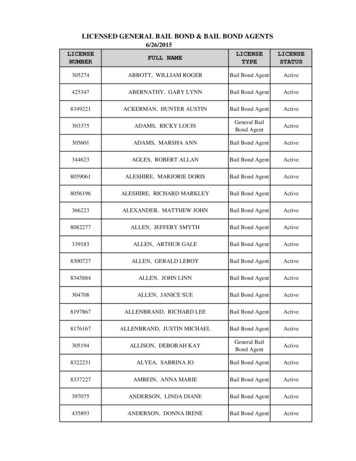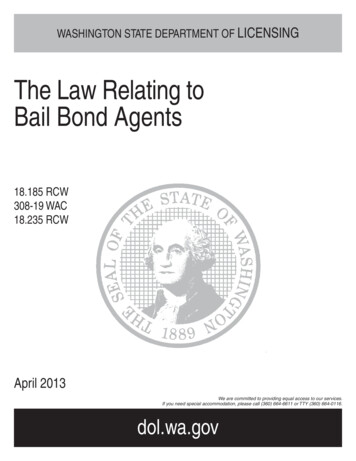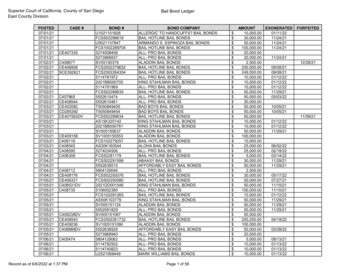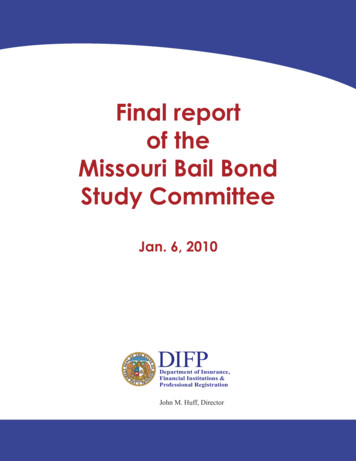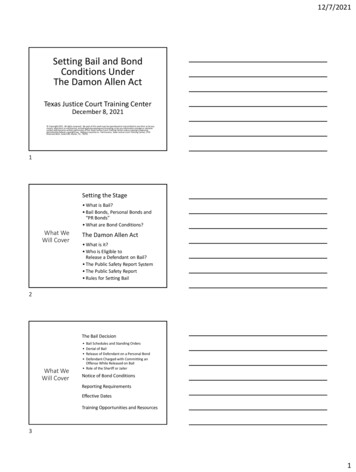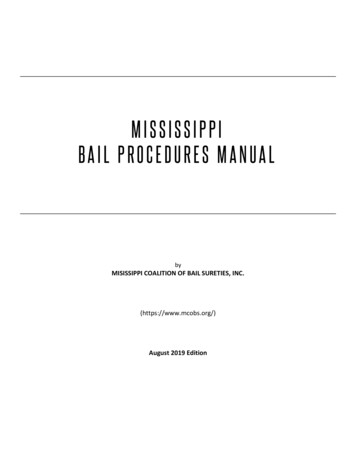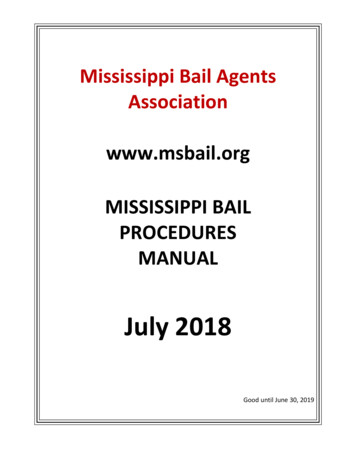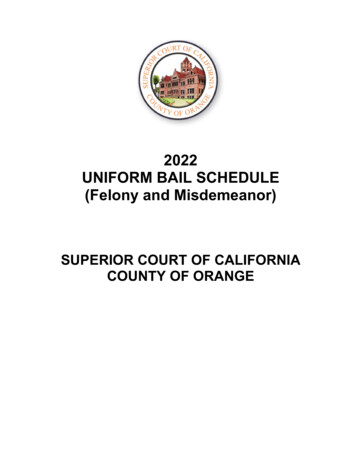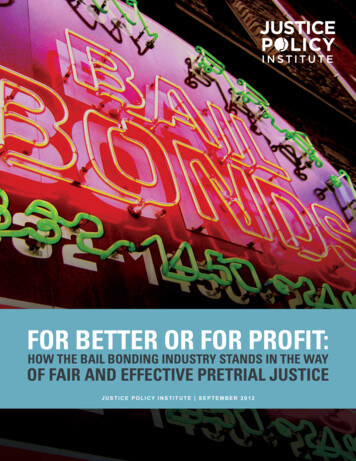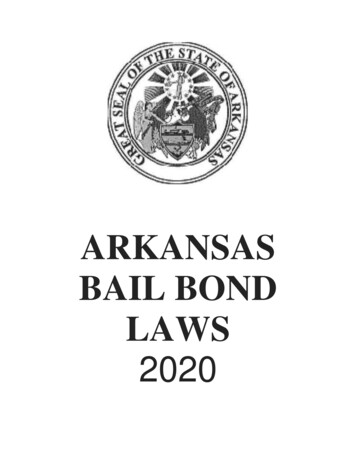
Transcription
ARKANSASBAIL BONDLAWS2020
INDEX5-54-120Failure to 11Fees for Bail or Delivery of Bond (Municipal Police) 416-19-408Improper Venue of Action416-81-109Bail516-81-110Return on the warrant516-84-101Definitions516-84-102Persons authorized to take bail616-84-103Qualification of Surety616-84-104Additional Security716-84-105Responsibility of officer taking bail716-84-106Attorneys and officers not to be sureties816-84-107Form of Bond816-84-108Bonds not void for want of form816-84-109Irregularity of bail bond or recognizance916-84-110Bail before conviction916-84-111Bail during trial1016-84-112Entering of recognizance on court minutes1016-84-113Application for bail1016-84-114Surrender of defendant1016-84-115Deposit of money in lieu of bail1116-84-116Recommitment after bail or deposit of money1216-84-201Action on bond in district courts1216-84-202Disposition of deposit13
16-84-203Certain absences excused1316-84-207Action on bail bonds in circuit courts1416-85-101Right to Attorney, physician, and phone calls1516-90-105Verdict of guilty1616-94-216Bail1616-94-217Discharge of 717-19-103Civil and criminal ions1817-19-106Professional Bail Bond Company and Professional BailBondsman Licensing Board1917-19-107Exception to education requirements1917-19-108Rules and regulations2017-19-109Advertising by professional bail bond companies2017-19-110Licensed bail bond agent2017-19-111Fees2017-19-112Unpaid Bond Forfeiture Judgment Limits2217-19-201Licenses required2217-19-202Applications [Effective until May 1st, 2021]2317-19-202Applications [Effective May 1st, 2021]2517-19-203Character references2717-19-204Examination2717-19-205Letter of credit or certificate of deposit required2817-19-206Duties of Board2817-19-207Expiration and renewal29
17-19-208Civil Action - Administrative Action2817-19-209Violations - Hearings3017-19-210Suspension and Penalties - -19-301Premiums3317-19-302Collateral - Receipt required3717-19-303Bail bonds - Numbers - Report3717-19-304[Repealed]3717-19-305Appearance bond3717-19-306Posting of bondsman t of program - Schedule of fees3919-5-1088Bail Bondsman Board Fund4019-6-820Bail Bond Recovery Fund4021-6-307Sheriff's Fees40
15-54-120. Failure to appear.(a)A person commits the offense of failure to appear if he or she fails to appear withoutreasonable excuse subsequent to having been:(1)Cited or summonsed as an accused; or(2)Lawfully set at liberty upon condition that he or she appear at a specified time,place, and court.(b) Failure to appear is a Class C felony if the required appearance was to answer a charge offelony or for disposition of any felony charge either before or after a determination of guilt ofthe felony charge.(c)(l) Failure to appear is a Class A misdemeanor if the required appearance was to answer acharge of misdemeanor or for disposition of any misdemeanor charge either before or after adetermination of guilt of the misdemeanor charge.(2) Failure to appear is a Class C misdemeanor if the required appearance was to answer aviolation.(d) This section does not apply to an order to appear imposed as a condition of suspension orprobation pursuant to § 5-4-303 or an order to appear issued prior to a revocation hearingpursuant to § 5-4-310.HISTORY:Acts 1975, No. 280, § 2820; A.S.A. 1947, § 41-2820; Acts 1991, No. 916, § 1.5-71-208. Harassment.(a)A person commits the offense of harassment if, with purpose to harass, annoy, oralarm another person, without good cause, he or she:(1)Strikes, shoves, kicks, or otherwise touches a person, subjects that person tooffensive physical contact or attempts or threatens to do so;(2) In a public place, directs obscene language or makes an obscene gesture to or atanother person in a manner likely to provoke a violent or disorderly response;(3) Follows a person in or about a public place;(4) In a public place repeatedly insults, taunts, or challenges another person in amanner likely to provoke a violent or disorderly response;(5) Engages in conduct or repeatedly commits an act that alarms or seriously annoysanother person and that serves no legitimate purpose; or(6) Places a person under surveillance by remaining present outside that person's school,place of employment, vehicle, other place occupied by thatperson, or residence, other than the residence of the defendant, for no purpose other than toharass, alarm, or annoy.(b) Harassment is a Class A misdemeanor.
2(c) It is an affirmative defense to prosecution under this section if the actor is a lawenforcement officer, licensed private investigator, attorney, process server, licensed bailbondsman, or a store detective acting within the reasonable scope of his or her duty whileconducting surveillance on an official work assignment.(d)(l) Upon pretrial release of the defendant, a judicial officer shall enter a no contact orderin writing consistent with Rules 9.3 and 9.4 of the Arkansas Rules of Criminal Procedureand shall give notice to the defendant of penalties contained in Rule 9.5 of the Arkansas Rulesof Criminal Procedure.(2) This no contact order remains in effect during the pendency of any appeal of aconviction under this section.(3) The judicial officer or prosecuting attorney shall provide a copy of this no contactorder to the victim and arresting agency without unnecessary delay.(e) If the judicial officer has reason to believe that mental disease or defect of thedefendant will or has become an issue in the cause, the judicial officer shall enter suchorders as are consistent with § 5-2-305.HISTORY:Acts 1975, No. 280, § 2909; 1985, No. 711, § 1; A.S.A. 1947, §41-2909; Acts 1993, No. 379, § 5; 1993, No. 388, § 5; 1995, No. 1302, § 3.5-71-229. Stalking.(a)(l) A person commits stalking in the first degree if he or she knowingly engages in a courseof conduct that would place a reasonable person in the victim's position under emotionaldistress and in fear for his or her safety or a third person's safety, and the actor:(A)ActthistheDoes so in contravention of an order of protection consistent with the Domestic Abuseof 1991, § 9-15-101 et seq., or a no contact order as set out in subdivision (a)(2)(A) ofsection, protecting the same victim, or any other order issued by any court protectingsame victim;(B) Has been convicted within the previous ten (10) years of:(i)Stalking in the second degree;(ii) Terroristic threatening, § 5-13-301 or terroristic act§ 5-13310; or(iii) Stalking or threats against another person's safety under the statutory provisions of anyother state jurisdiction; or(C) Is armed with a deadly weapon or represents by word or conduct that he or she isarmed with a deadly weapon.(2)(A) Upon pretrial release of the defendant, a judicial officer shall enter a no contact orderin writing consistent with Rules 9.3 and 9.4 of the Arkansas Rules of Criminal Procedure andshall give notice to the defendant of penalties contained in Rule 9.5 of the Arkansas Rules ofCriminal Procedure.(B) The no contact order remains in effect during the pendency of any appeal of a convictionunder this subsection (a) of this section.
3(C) The judicial officer or prosecuting attorney shall provide a copy of the no contact orderto the victim and the arresting law enforcement agency without unnecessary delay.(D) If the judicial officer has reason to believe that mental disease or defect of thedefendant will or has become an issue in the cause, the judicial officer shall enter suchorders as are consistent with § 5-2-305.(3)Stalking in the first degree is a Class C felony.(b)(l) A person commits stalking in the second degree if he or she knowingly engages in acourse of conduct that harasses another person and makes a terroristic threat with thepurpose of placing that person in imminent fear of death or serious bodily injury or placingthat person in imminent fear of the death or serious bodily injury of his or her immediatefamily.(2)(A) Upon pretrial release of the defendant, a judicial officer shall enter a no contact orderin writing consistent with Rules 9.3 and 9.4 of the Arkansas Rules of Criminal Procedure andshall give notice to the defendant of penalties contained in Rule 9.5 of the Arkansas Rules ofCriminal Procedure.(B) The no contact order remains in effect during the pendency of any appeal of aconviction under this subsection (b).(C) The judicial officer or prosecuting attorney shall provide a copy of the no contact orderto the victim and arresting law enforcement agency without unnecessary delay.(D) If the judicial officer has reason to believe that mental disease or defect of thedefendant will or has become an issue in the cause, the judicial officer shall enter suchorders as are consistent with § 5-2-305.(3) Stalking in the second degree is a Class D felony.(c)(l) A person commits stalking in the third degree if he or she knowingly commits anact that would place a reasonable person in the victim's position under emotional distressand in fear for his or her safety or a third person's safety.(2)(A) Upon pretrial release of the defendant, a judicial officer shall enter a no contactorder in writing consistent with Rules 9.3 and 9.4 of the Arkansas Rules of CriminalProcedure and shall give notice to the defendant of the penalties contained in Rule 9.5of the Arkansas Rules of Criminal Procedure.(B) The no contact order remains in effect during the pendency of any appeal of aconviction under this section (c).(C) The judicial officer or prosecuting attorney shall provide a copy of the no contact orderto the victim and the arresting law enforcement agency without unnecessary delay.(D) If the judicial officer has reason to believe that mental diseaseor defect of the defendant will or has become an issue in the cause, the judicial officershall enter orders consistent with §5-2-305.(3) Stalking in the third degree is a Class A misdemeanor.(d) It is an affirmative defense to prosecution under this section if the actor is a law enforcementofficer, licensed private investigator, attorney, process server, licensed bail bondsman, or a storedetective acting within the reasonable scope of his or her duty while conducting surveillance on anofficial work assignment.(e) It is not a defense to a prosecution under this section that the actor was not givenactual notice by the victim that the actor's conduct was not wanted.
4(f)As used in this section:(1)(A) "Course of conduct" means a pattern of conduct composed of two(2) or more acts separated by at least thirty-six (36) hours, but occurring within one (1)year including without limitation and act in which the actor directly, indirectly, or througha third party by any action, method, device, or means follows, monitors, observes, placesundersurveillance, threatens, or communicates to or about a person or interfereswith a person's property.(B)(i) "Course of conduct" does not include constitutionally protected activity.(ii) If the defendant claims that he or she was engaged in a constitutionally protectedactivity, the court shall determine the validity of that claim as a matter of law and, iffound valid, shall exclude that activity from evidence;(2)(A) "Emotional distress" means significant mental suffering or distress.(B) "Emotional distress" does not require that the victim sought or received medical orother professional treatment or counseling; and(3) "Harasses" means an act of harassment as prohibited by§ 5-71208;HISTORY:Acts 1993, No. 379, §§ 1-3; 1993, No. 388, §§ 1-3; 1995, No.1302, § 1; 2007, No. 827, §94, 2013, No. 1014 § 1, 2013, No.1014, §1.14-52-111. Fees for bail or delivery bond.A municipal police department in this state may charge and collect a fee of twenty dollars( 20.00) for taking and entering a bail or delivery bond.HISTORY:Acts 1997, No. 252, § 1; 2003, No. 1347, § 1 2013, No. 1281 §1.16-19-408. Improper venue of action.(a) Whenever an objection is made by a defendant in any action cognizable before a justiceof the peace or a municipal court, instituted by summons or warrant, or in an action by anattachment, an action for the recovery of personal property, an action by provisionalremedy, or in any criminal action or proceeding, that the action was brought before ajustice of the peace or a municipal court wherein the venue is improper under the laws ofthe State of Arkansas, the court shall immediately hear proof on the question. If it isestablished by proof that the venue is improper, then all further proceedings shall bediscontinued and the justice of the peace or clerk of the municipal court shall transmit to ajustice of the peace or municipal court wherein the venue is proper all the original papersin the case, including the bail bond, if there is any.(b) If the defendant is in custody, he shall be taken and delivered before the justice ofthe peace or the municipal court, and the bail, if any, shall be liable for the appearance ofthe defendant in the court to which the papers are transmitted.(c) The court to which the papers are transmitted shall proceed to try the action in allrespects as if the action had been originally brought to the court.
5HISTORY:Acts 1949, No. 224, § 1; A.S.A. 1947, § 26-310.16-81-109. Bail.(a)(1) When any sheriff or other law enforcement officer makes an arrest, he or she isauthorized to take and to approve bail in the manner providedby law wherever he or she makes the arrest.(2) If the offense charged is a misdemeanor, the person arrested may immediately givebail for appearing on a day to be named in the bail bond before the judge or magistratewho issued the warrant or before the court having jurisdiction to try the offense. Thesheriff or other officer making the arrest may be authorized by the judge or magistrateissuing the warrant to take the bail by an endorsement made on the warrant to thateffect.(b)(1) If the defendant gives bail for his or her appearance before the judge ormagistrate for an examination of the charge, as provided in subsection (a) of thissection, the sheriff or officer taking the bail shall fix the day of the defendant'sappearance.(2) A deviation from the provisions of subdivision (b)(l) ofthis section shall not,however, render the bail bond invalid.HISTORY:Crim. Code, §§ 25-27; Acts 1871, No. 49, § 1 [25]; C. & M. Dig.,§§ 2896-2898; Init.Meas. 1936, No. 3, § 19, Acts 1937, p. 1384; Pope's Dig.,§§ 3712-3714, 3865; A.S.A.1947, §§ 43-411, 43-418 -- 43-420; Acts 2005, No. 1994, § 268.16-81-110. Return on the warrant.(a)(1) The sheriff or officer who has executed a warrant of arrest shall make a writtenreturn on the warrant of the time and manner of executing it and deliver the warrantto the judge or magistrate before whom the defendant is brought.(2) If bail is given as provided in § 16-81-109(a)(2), the officer shall deliver the warrantand bail bond to the judge or magistrate before whom, or to the clerk of the court inwhich, the defendant is bound by the bail bond to appear.(b) If the arrest is made in a different county from that in which the offense is chargedto have been committed and bail is given, the sheriff or officer may transmit the warrantand bail bond by mail to the person to whom by subsection (a) of this section he or sheis required to deliver them.HISTORY:Crim. Code, §§ 30, 31; C. & M. Dig., §§ 2901, 2902; Pope's Dig.,§§ 3717, 3718; A.S.A. 1947,§§ 43-421, 43-422; Acts 2005, No. 1994, §268.16-84-101. Definitions.As used in this chapter:
6(1) "Admission to bail" means an order from a competent court ormagistrate that the defendant be discharged from actual custody on bailand fixing the amount of the bail;(2) "Direct supervision" means the person is in the physical presence ofand acting pursuant to instructions from an Arkansas-licensed bail bondagent;(3) "Professional bail bondsman" means an individual licensed as aprofessional bail bondsman by the Professional Bail Bond Company andProfessional Bail Bondsman Licensing Board pursuant to§ 17-19-201 etseq.;(4) "Professional bail bond company" means a person holding aprofessional bail bond company license issued by the Professional Bail BondCompany and Professional Bail Bondsman Licensing Board pursuant to §17-19-201 et seq.;(5) "Surety" means the person who becomes the surety for the appearanceof the defendant in court; and(6)(A) "Taking of bail" or "take bail" means the acceptance by a personauthorized to take bail of the undertaking of a sufficient surety for theappearance of the defendant according to the terms of the undertaking, orthat the surety will pay to the court the sum specified.(B) "Taking of bail" or "take bail" shall not include the fixing of theamount of bail and no person other than a competent court or magistrateshall fix the amount of bail.HISTORY:Acts 1989, No. 417, § 5; 1997, No. 973, § 1; 2001, No. 1387, §1.16-84-102. Person authorized to take bail(a) The following may take bail:(1) A judge, magistrate, or clerk of the court;(2) A sheriff or deputy sheriff with respect to any person committed tothe common jail of the county;(3) Any law enforcement officer designated by a municipal policedepartment with respect to any person committed to a municipal jail; and(4) A law enforcement officer making an arrest as authorized under §16-81-109.(b) A constable shall not take bail.HISTORY:Acts 1989, No. 417, § 5; 2005, No. 1994, § 270.16-84-103 Qualification of surety.(a) The surety shall be:
7(1) A professional bail bondsman acting through a professional bail bondcompany; or(2) A resident of the state, owner of visible property, over and abovethat exempt from execution, to the value of the sum in which bail isrequired, and shall be worth that amount after the payment of the surety'sdebts and liabilities.(b)(l)(A)(i) The person or persons offered as surety shall be examinedon oath in regard to qualifications as surety, and any officerauthorized to take bail is authorized to administer the oath,reduce the statements on oath to writing, and require theperson or persons offered as surety to sign the statement.(ii) Other proof may also be taken in regard to the sufficiency ofthe surety.(B) Prior to submission to the court or magistrate, the statementshall also be signed by the sheriff or chief of police in the jurisdiction wherethe defendant is charged.(2) Proof that the surety is a licensed professional bail bondsman shallbe deemed sufficient proof of the sufficiency of the surety, and the suretyshall be accepted by all courts in this state or by any individual authorizedto take bail under the provisions of§ 16-84-102.(c) No person shall be taken as surety unless the court or magistrate issatisfied, from proof and examination on oath, of the sufficiency of theperson according to the requisitions of subsection (b) of this section.(d) Where more than one (1) person is offered as surety, they shall bedeemed sufficient if, in the aggregate, they possess the qualificationsrequired.HISTORY:Acts 1989, No. 417, § 5; 1997, No. 973, § 2; 2003, No. 1648, §1.16-84-104. Additional security.There shall be no rules, regulations, or requirements enacted by anyjudge, magistrate, sheriff, or other officer of the court, requiring anyprofessional bail bondsman or professional bail bond company to post anysum of security in addition to that required by the Professional Bail BondCompany and Professional Bail Bondsman Licensing Board pursuant to §17-19-205 as a requirement for acceptance or writing bail bonds.HISTORY:Acts 1989, No. 417, § 5; 1997, No. 973, § 3.16-84-105. Responsibility of officer taking bail.(a) The officer who takes bail shall be officially responsible for thesufficiency of the surety if taken other than through a professional bailbondsman.
8(b) If the surety is not a professional bail bondsman, and the defendant has not yet appeared before ajudicial officer pursuant to Rule 9 of the Arkansas Rules of Criminal Procedure, the officer shall file astatement with the court describing the property of the surety upon which the sufficiency of the suretyis based. The description of the property shall include the value of the property. The statement shallalso be signed by the sheriff or chief of police in the jurisdiction where the defendant is charged.(c) The officer who takes bail shall give a prenumbered written receipt for thecollateral. The receipt shall give in detail a full account of the collateralreceived.(d) An officer who takes bail shall not be liable for any bond ordered by ajudicial officer under Rule 9.2(b)(i) or (ii) of the Arkansas Rules of CriminalProcedure.HISTORY:Acts 1989, No. 417, § 5; 1995, No. 470, § 1.16-84-106. Attorneys and officers not to besureties.No attorney, solicitor, or counselor at law or in equity, clerk, sheriff, chief of police, law enforcementofficer, or other person concerned in the execution of any process, shall become a personal guarantoror surety in any criminal proceeding.HISTORY:Acts 1989, No. 417, § 5; 1997, No. 1046, § 1.16-84-107. Form of bond.(a) The undertaking of the surety, other than by a professional bailbondsman, shall be substantially as follows:"A.B., being in custody, charged with the offense of . (naming or briefly describing it), andbeing admitted to bail in the sum of. . dollars, we C.D., of . (stating his place ofresidence), and E.F., of . (stating his place of residence), hereby undertake that the abovenamed A.B. shall appear in the . court on the . day of its . termto answer said charge, and shall at all times render himself or herself amenable to the orders andprocess of said court in prosecution of said charge, and, if convicted, shall render himself in executionthereof; or if he fail to perform eitherof these conditions, that we will pay to the appropriate court the sum of .dollars."(b) If the surety is a professional bail bondsman, the undertaking of thesurety shall be in a form prescribed by the regulations of the ProfessionalBail Bond Company and Professional Bail Bondsman Licensing Board.HISTORY:Acts 1989, No. 417, § 5; 1997, No. 973, § 4.16-84-108. Bonds not void for want of form.No prosecution, appeal, nonresident, or attachment bond, nor any otherstatutory bonds of any party, plaintiff, or defendant in any court of justice,in this state, nor anyrecognizance in any criminal cause in this state, shallbe declared null and void for the want of form ifthe intent of the bond canbe plainly deduced from the body of the bond or recognizance.
9HISTORY:Acts 1989, No. 417, § 5.16-84-109. Irregularity of bail bond orrecognizance.(a) No bail bond or recognizance shall be deemed to be invalid by:(1) Reason of any variance between its stipulations and the provisionsof this chapter;(2) The failure of the judge or magistrate or officer to transmit ordeliver the bail bond or recognizance at the times provided in thissubchapter; or(3) Any other irregularity so that it is made to appear that thedefendant was:(A) Legally in custody;(B)(i) Charged with the public offense; and(ii) Discharged from the offense by reason of the giving of thebond or recognizance; and(C) Can be ascertained from the bond or recognizance, that thesurety undertook that the defendant should appear before a judge ormagistrate for the trial of the offense.(b)(l) If no day is fixed for the appearance, or an impossible day, or a dayin vacation, the bond or recognizance, if for his or her appearance before a judge or magistrate, shallbe considered as binding the defendant so toappear and surrender himself or herself into custody for an examination of the charge in twenty (20)days from the time of his or her giving the bond or recognizance.(2) The bond or recognizance, if for his or her appearance for trial incourt, shall be considered as binding the defendant to appear and surrender himself or herself intocustody on the first day of the next term of the court which shall commence more than ten (10) daysafter the giving of the bond or recognizance.HISTORY:Acts 1989, No. 417, § 5; 2005, No. 1994, § 271.16-84-110. Bail before conviction.Before conviction, the defendant may be admitted to bail for his or herappearance:(1) Before a judge or magistrate for an examination of the charge,where the offense charged is a misdemeanor;(2) In the court to which he or she is sent for trial;(3) To answer an indictment which has been found against him or her; or(4) In a criminal action.
10HISTORY:Acts 1989, No. 417, § 5; 2005, No. 1994, § 271.16-84-111. Bail during trial.(a) During the trial of an indictment for a misdemeanor, the defendant may remain on bail.(b) However, for a felony when a defendant is upon bail, he or she mayremain upon bail or be kept in actual custody as the court may direct. If the defendant remains on bail,any surety's liability shall be exonerated unless the surety has agreed to remain as the surety untilfinal judgment is rendered.HISTORY:Acts 1989, No. 417, § 5.16-84-112. Entering of recognizance on courtminutes.All recognizances required or authorized to be taken in any criminalproceeding, in open court, by any court of record shall be entered on theminutes of the court, and the substance thereof shall be read to the personrecognized.HISTORY:Acts 1989, No. 417, § 5.16-84-113. Application for bail.(a) If the defendant is committed to jail and the application for bail ismade to a judge or magistrate during vacation, it must be by writtenpetition signed by the defendant or his or her counsel briefly stating theoffense for which he or she is committed and naming the persons offered as surety.(b) In all other cases, the application may be made orally to the judge ormagistrate.HISTORY:Acts 1989, No. 417, § 5; 2005, No. 1994, § 272.16-84-114. Surrender of defendant.(a)(l) At any time before the forfeiture of their bond, the surety maysurrender the defendent or the defendent may surrender himself or herself to the jailer of the countyin which the offense was committed.(2) However, the surrender must be accompanied by a certified copy ofthe bail bond to be delivered to the jailer, who must detain the defendant in custody thereon as upon acommitment and give a written acknowledgment of the surrender.(3) The surety shall thereupon be exonerated.
11(b)(l) For the purpose of surrendering the defendant, the surety mayobtain from the officer having in his or her custody the bail bond orrecognizance a certified copy thereof, and thereupon at any place in thestate may arrest the defendant.(2) No person other than an Arkansas-licensed bail bond agent, anArkansas-licensed private investigator, a certified law enforcement officer,or a person acting under the direct supervision of an Arkansas-licensed bail bond agent shall beauthorized to apprehend, detain, or arrest a defendant on a bail bond, wherever issued, unless thatperson is licensed as a bail bond agent by the state where the bail bond was written.(3) No person shall represent himself or herself to be a bailenforcement agent, bounty hunter, or similar title in this state.(4) Any bail bond agent attempting to apprehend a defendant shallnotify the local law enforcement agency or agencies of his or her presenceand provide the local law enforcement agency or agencies with thedefendant's name, charges, and suspected location.(5) Any person who violates any provision of this section shall be guiltyof a Class D felony.(c) The surety may arrest the defendant without the certified copy.(d) If the surety has good cause for surrendering the defendant and hascomplied with the provisions of this section in surrendering the defendant,there shall be no requirement that the surety return part or all of thepremium paid for the bail bond.HISTORY:Acts 1989, No. 417, § 5; 1995, No. 593, § 1; 1999, No. 1445,§1; 2001, No. 1387, § 2.16-84-115. Deposit of money in lieu of bail.Notwithstanding any rule of criminal procedure to the contrary;(1)(A) Whenever the defendant is admitted to bail in a specified sum, heor she may deposit the sum with the proper city or county official in the city or county in which the trialis directed to be had and take from the official a receipt of the deposit, upon delivering which to theofficer in whose custody he or she is, he or she shall be discharged.(B) After bail has been taken, a deposit may in like manner be made ofthe sum mentioned in the bail bond, which shall exonerate the surety.(2) Where money is deposited, the proper city or county official shall holdand pay the money according to the orders of the court having jurisdictionto try the offense, and he or she and his or her sureties shall be liable forthe money on their official bond.(3) Upon judgment being rendered against a defendant for fine and costs,the court rendering judgment may order any money deposited agreeably tothis section to be applied to the payment thereof. This subdivision (a)(3)shall not apply to a bail bond of a bail bondsman.(4) The mayor shall designate the city official or officials who may accept a deposit of money in lieu ofbail, and the county judge shall designate the county official or officials authorized to accept a depositof money in lieu of bail.
12HISTORY:Acts 1989, No. 417, § 5; 1991, No. 720, § 1.16-84-116. Recommitment after bail or deposit ofmoney.(a) The court in which a prosecution for a public offense is pending may, by an order, direct thedefendant to be arrested and committed to jail until legally discharged, after he or she has given bail,or deposited money in lieu thereof, in the following cases:(1) When by having failed to appear, a forfeiture of bail or of the moneydeposited has been incurred;(2) When the court is satisfied that his or her surety, or either of them,is dead, or insufficient, or has moved from the state;(3) Upon an indictment's being found for an offense not bailable.(b) Upon the order b
16-84-108 Bonds not void for want of form 8 16-84-109 Irregularity of bail bond or recognizance 9 16-84-110 Bail before conviction 9 . 16-84-207 Action on bail bonds in circuit courts 14 16-85-101 Right to Attorney, physician, and phone calls 15 16-90-105 Verdict of guilty 16 16-94-216 Bail 16 .
